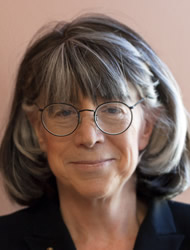
| Vol.
XXIX No.
5 May / June 2017 |
| contents |
| Printable Version |
Susan Silbey New Faculty Chair

Professor Susan S. Silbey will succeed Krishna Rajagopal as Chair of the Faculty on July 1, 2017, after serving as Chair-elect during the current academic year. Susan is the Leon and Anne Goldberg Professor of Humanities, Sociology and Anthropology in the School of Humanities, Arts and Social Sciences, and Professor of Behavioral and Policy Sciences in the Economic Sociology group and Institute for Work and Employment Relations in Sloan. Professors Rick Danheiser (Chemistry) and Craig Carter (Materials Science and Engineering) will serve, respectively, as Associate Chair and Secretary of the Faculty.
Susan grew up in Brooklyn, New York, attending Erasmus Hall High School and spending entirely too much time hanging out on the street corners of Flatbush – but this turned out better than expected: it was there that she became buddies with her future husband, Bob Silbey, with whom she spent the next 51 years. After a BA from CUNY Brooklyn College and a PhD from the University of Chicago, both in political science, Susan spent 26 years as a sociology professor at Wellesley College, and for the last 17 years she has been in MIT’s Anthropology department, eight of those as Head. Throughout this time, while studying and working in several disciplines, Susan has been doing the same thing: conducting empirical research on how law works. She is preoccupied with understanding what makes the law such a durable and powerful institution, more similar in its fundamental processes across its 4,000 years than any other social institution – including the family, the state, and the economy.
Susan is a sociologist of law and organizations. From her very first project – observing the Massachusetts Attorney General’s Office of Consumer Protection – she has been explaining how legal processes do whatever it is that they do.
She tracks formal legal doctrine in statutes, regulations, and judicial opinions from enactment through implementation, and ultimately to citizens’ experiences and interpretations of those laws. The formally written doctrine taught in law schools represents but a small fraction, and thus an incomplete if not inaccurate account, of what happens on the ground in everyday life: in shops, offices, universities, homes, and street corners across the nation. Susan’s most widely used work constructs a model of the cultural representations of law that circulate in popular consciousness and discourse. The Common Place of Law: Stories from Everyday Life documents how Americans experience and talk about law, simultaneously a game played by unruly lawyers and a solemn process that temporally and spatially transcends the actions of particular individuals, an ahistorical aspirational norm coupled to pragmatic, locally situated practices. Americans revere the law, but at the same time often resent and resist it. They seek the protection of the law and actively avoid it. Rather than weakening the institution, however, Susan and her co-authors show how these contradictory accounts constitute a matrix of reinforcing narratives that provide legitimation while creating the opportunities for critique, all contained within the same institution.
Susan has been developing a general model of the structure of institutional cultures across a variety of settings (e.g., alternatives to law in negotiation and mediation, children studying law in public schools, engineering education, the organization of scientific laboratories). Her most recent work concentrates on the ways in which environmental, health, and safety regulations have been infiltrating hospitals, laboratories, and other hazardous workplaces. With her graduate students, she has been identifying examples of successful, pragmatic regulatory enforcement that keeps organizational practices within an acceptable range of variation close to regulatory specifications, but not necessarily perfectly compliant.
At MIT, Susan has been Secretary of the Faculty, and also served on more than a dozen committees including, among others, the Faculty Policy Committee, Committee on Academic Performance, Killian and Edgerton Award Committees, MITx Policy and Privacy Committees, SHASS Equal Employment Opportunity Committee, Budget Task Force, and the 2012 Presidential Search Committee. She is the recipient of numerous prizes and awards for her research, including several best article prizes from the American Sociological Association, a Doctor Honoris Causa from École Normale Supérieure de Cachan in France, a John Simon Guggenheim Foundation Fellowship, a Russell Sage Foundation Fellowship, the Harry Kalven Jr. Prize for advancing the sociology of law, and the Stanton Wheeler Prize, SHASS Levitan Prize, and Committed to Caring awards for mentoring graduate students. She is Past President of the Law & Society Association, and a fellow of the American Academy of Political and Social Science. She currently sits on two panels for the National Academies of Sciences, Medicine, and Engineering: Performance Based Regulation of Hazardous Materials and the Committee on Science, Technology, and Law.
Susan lives in the Back Bay and West Falmouth, where she maintains with her sister extensive organic vegetable and hydrangea gardens when not out sailing on Buzzards Bay. Susan's late husband, Bob (web.mit.edu/robertsilbey/events/memorial.html), joined the MIT Department of Chemistry in 1966. He served as Department Head from 1990-1995, and as Dean of Science from 2000-2007. The Silbeys’ daughters, sons-in-law, and grandchildren live in Cambridge and Brookline.
| Back to top | |
| Send your comments |
| home this issue archives editorial board contact us faculty website |